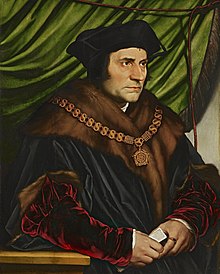Sir Thomas More PC (7 February 1478 – 6 July 1535), venerated in the Catholic Church as Saint Thomas More,[2] was an English lawyer, judge,[3] social philosopher, author, statesman, amateur theologian, and noted Renaissance humanist.[4] He also served Henry VIII as Lord High Chancellor of England from October 1529 to May 1532.[5] He wrote Utopia, published in 1516, which describes the political system of an imaginary island state.[6]
More opposed the Protestant Reformation, directing polemics against the theology of Martin Luther, Huldrych Zwingli and William Tyndale. More also opposed Henry VIII's separation from the Catholic Church, refusing to acknowledge Henry as supreme head of the Church of England and the annulment of his marriage to Catherine of Aragon. After refusing to take the Oath of Supremacy, he was convicted of treason on what he stated was false evidence, and was executed. At his execution, he was reported to have said: "I die the King's good servant, and God's first."
Pope Pius XI canonised More in 1935 as a martyr.[7] Pope John Paul II in 2000 declared him the patron saint of statesmen and politicians.[8][9][10]
- ^ "Topic 1.3: The Northern Renaissance" (PDF).
- ^ "St. Thomas More". savior.org. Retrieved 29 May 2024.
- ^ Cite error: The named reference
:0was invoked but never defined (see the help page). - ^ Kristeller, Paul Oskar (1980). "Thomas More as a renaissance humanist". Moreana. 17 (Number 65-6 (1–2): 5–22. doi:10.3366/more.1980.17.1-2.3. ISSN 0047-8105.
- ^ Linder, Douglas O. "The Trial of Sir Thomas More: A Chronology". University Of Missouri-Kansas City (UMKC) School Of Law.
- ^ King, Margaret L. (2014). Renaissance Humanism: An Anthology of Sources. Hackett Publishing. p. 157. ISBN 978-1-62466-146-4.
- ^ "Homily at the Canonization of St. Thomas More" "The Center for Thomas More Studies: Canonization of Thomas More". Archived from the original on 4 March 2016. Retrieved 14 April 2012. at The Center for Thomas More Studies at the University of Dallas, 2010, citing text "Recorded in The Tablet, June 1, 1935, pp. 694–695"
- ^ Cite error: The named reference
JP2PatronSaintwas invoked but never defined (see the help page). - ^ Jubilee of parliament and government members, proclamation of Saint Thomas More as patron of statesmen vatican.va
- ^ "Holy Days". Worship – The Calendar. Church of England. 2011. Archived from the original on 25 December 2018. Retrieved 20 April 2011.

